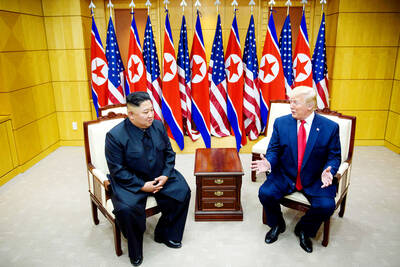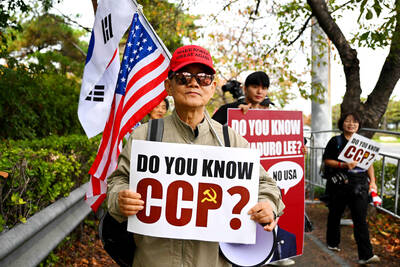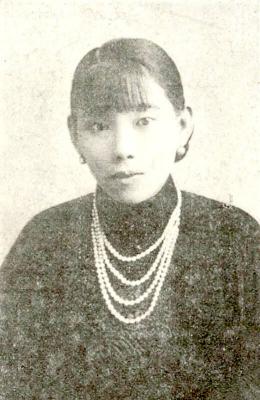I first encountered Marc Moskowitz when I read his extraordinary study of the Taiwanese cult of propitiating fetus ghosts [reviewed in the Taipei Times on Aug. 12, 2001], one of the best books I’ve ever read about Taiwan. Now he’s come up with Cries of Joy, Songs of Sorrow, less sensational perhaps, but more far-reaching in its implications.
It’s a study of Mandarin-language pop music, or Mando-pop, and it quickly becomes a paean of praise for Taiwan. Not only does it assert that this musical genre is far more serious and interesting than many critics have supposed. It goes on to demonstrate that its Taiwanese practitioners easily outstrip all others, taking a huge swathe of the vast worldwide Chinese-speaking audience by storm.
This thesis implies even more. What it suggests is that Taiwan — which could be viewed by those who only look at the politics of the case as being a tiny entity doomed to be dominated and eventually absorbed by its far larger neighbor — is in the process of winning some sort of culture war for the hearts, and even the minds, of the entire pan-Chinese population.
Shanghai was where the Mando-pop genre was effectively born, Moskowitz tells us, in the 1920s jazz era. But it’s Taiwan that is today “the undisputed ruler in this terrain.” As for Beijing, it can be heard “shouting its condemnation of the music from the periphery.”
“Taiwan’s counter-invasion [of mainland China] has had profound effects on PRC culture,” he writes. Rather than spawn a watered-down version of Western popular music, as is sometimes asserted, it has created a new musical ethos — a blend of traditional Chinese, Japanese, Taiwanese and Western musical styles that has been transformed into something new and entirely delightful for Chinese-speaking audiences.
“It is nothing less than astounding,” Moskowitz insists, “that Taiwan, which houses 23 million people, can dictate the musical tastes of a nation of 1.3 billion,” so much so that the government in Beijing “seems to worry that Taiwan is the proverbial tail wagging the PRC dog.”
This isn’t all. Crucial to the book’s argument is the idea that Mando-pop subtly subverts any assertive, male-oriented, patriarchal view of life — something authoritarian regimes have embraced everywhere in the world, and throughout history. In its place this soft southern music envisages a more feminine ethic — women as “emotional, gentle, and passive victims,” plus “a wider range of possible male identities,” notably this music’s characteristic wenrou (溫柔, “sensitive, tender”) stance.
There’s another consideration too. The lack of politics in Mando-pop, and its focus instead on personal lives, is actually a radical political statement. The celebration of people’s individuality, and their individual existences, represents in many ways, the author argues, “an ideology for what China’s future should be.”
In a crucial chapter, Moskowitz argues that the dominant place of women in Mando-pop means that a feminized stance has become associated with a sophisticated, internationalized lifestyle, though men may in reality often write the music and lyrics that the women perform. Assertive masculinity is seen as uncouth, and associated with an unpleasant recent past, a time best forgotten and, at least implicitly, disdained.
Melancholy too, and the often secret feelings of isolation and loneliness that come from living in a rootless urban environment, are themes that are especially valued by this music’s audiences. One of the author’s Shanghai interviewees says that in Europe people are more open, but the Chinese tend to cover things up. As a consequence they like this genre’s sad songs because they’re talking about feelings everyone has, but that Chinese sometimes have a hard time expressing.
There is much else in this fascinating book. The focus is everywhere on Taiwan (Moskowitz interviewed 18 people in Shanghai, but 65 in Taipei). Taiwanese KTV, the implications of the decline of CD sales following the arrival of downloading to MP3-players, the reputation of Taiwanese Aboriginals for an explicit sexual allure, a fan base that’s built up from live performances leading
to recording contracts, rather than companies recording a relative unknown and then promoting their product — all these are discussed.
There are many photos of Taiwanese singers, too, several of them (including a dramatic one of Elva Hsiao (蕭亞軒) promoting the Hong Kong movie Infernal Affairs (無間道) on the book’s front cover) credited to the Taipei Times.
Many prominent figures from the music business feature — Chang Chen-yue (張震嶽), Jolin Tsai (蔡依林), Wu Bai (伍佰), Jay Chou (周杰倫), David Tao (陶吉吉), Bobby Chen (陳昇), Singapore’s Stefanie Sun (孫燕姿), who made her career in Taiwan, and Taipei music producer George Trivino, among others.
Moskowitz allows his opponents to have their say, notably those — including some in Taiwan — who consider Mando-pop beneath their consideration. He quotes former Taipei Times reporter David Momphard, writing in 2003 (“Taiwan, where pop music is largely a pantheon of pretty faces”) and considers the accusation that Mando-pop singers rarely write their own songs, concluding that there’s no reason why such a system should necessarily be inferior to that prevailing in the West. Western singers rarely produce their own music videos, after all.
Moskowitz concludes as follows. “Mando-pop has dramatically reshaped PRC culture to make it look, act and sound more like Taiwan. It has ushered in a wealth of cultural values ... It has introduced transnational and global values in spite of the government’s best efforts to prevent this and it has provided a model to prioritize the individual in opposition to state and Confucian ideals.”
These may seem large claims to make for what the author accepts is “seemingly benign music.” Even so, Moskowitz at the very least makes the case
that there is a case to be made. As such, and despite its
comparative brevity, Cries of Joy, Songs of Sorrow is a notable and welcome publication.

Many people noticed the flood of pro-China propaganda across a number of venues in recent weeks that looks like a coordinated assault on US Taiwan policy. It does look like an effort intended to influence the US before the meeting between US President Donald Trump and Chinese dictator Xi Jinping (習近平) over the weekend. Jennifer Kavanagh’s piece in the New York Times in September appears to be the opening strike of the current campaign. She followed up last week in the Lowy Interpreter, blaming the US for causing the PRC to escalate in the Philippines and Taiwan, saying that as

US President Donald Trump may have hoped for an impromptu talk with his old friend Kim Jong-un during a recent trip to Asia, but analysts say the increasingly emboldened North Korean despot had few good reasons to join the photo-op. Trump sent repeated overtures to Kim during his barnstorming tour of Asia, saying he was “100 percent” open to a meeting and even bucking decades of US policy by conceding that North Korea was “sort of a nuclear power.” But Pyongyang kept mum on the invitation, instead firing off missiles and sending its foreign minister to Russia and Belarus, with whom it

The Chinese Communist Party (CCP) has a dystopian, radical and dangerous conception of itself. Few are aware of this very fundamental difference between how they view power and how the rest of the world does. Even those of us who have lived in China sometimes fall back into the trap of viewing it through the lens of the power relationships common throughout the rest of the world, instead of understanding the CCP as it conceives of itself. Broadly speaking, the concepts of the people, race, culture, civilization, nation, government and religion are separate, though often overlapping and intertwined. A government

Nov. 3 to Nov. 9 In 1925, 18-year-old Huang Chin-chuan (黃金川) penned the following words: “When will the day of women’s equal rights arrive, so that my talents won’t drift away in the eastern stream?” These were the closing lines to her poem “Female Student” (女學生), which expressed her unwillingness to be confined to traditional female roles and her desire to study and explore the world. Born to a wealthy family on Nov. 5, 1907, Huang was able to study in Japan — a rare privilege for women in her time — and even made a name for herself in the